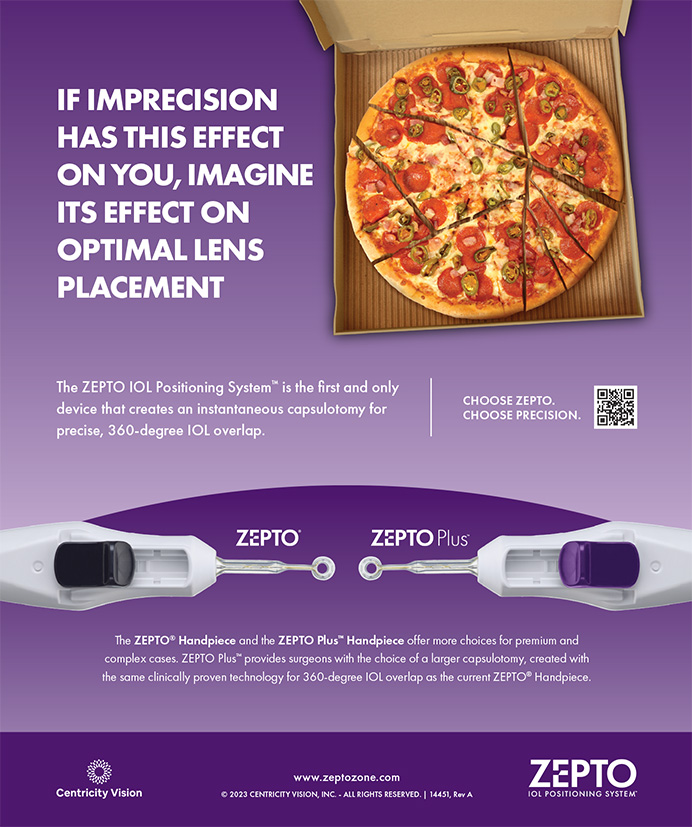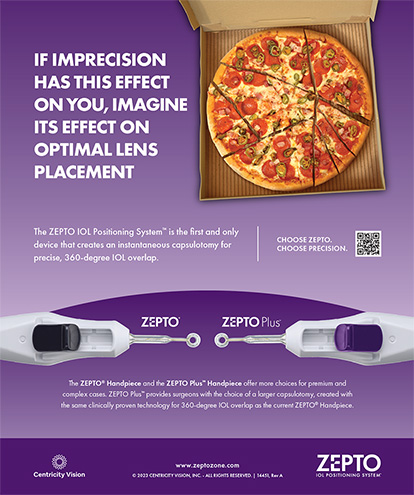Patients in their mid-50s often present to me for a LASIK evaluation, because they no longer want to use glasses for distance and reading. These baby boomers who have difficulty seeing at distance (due to congenital ametropia) and at near (due to aging and progressive presbyopia) typically have dysfunctional lens syndrome (DLS), a clinical entity that has been overlooked and inadequately characterized for years. In my experience, these patients are often best treated with refractive lens exchange (RLE).
For the past decade and a half, ophthalmic surgeons have been moving toward performing IOL surgery earlier in order to treat the source of the patient's vision issues. From an optics and functional vision standpoint, RLE may be the most effective treatment for these patients, many of whom suffer from DLS.
I explain to patients with DLS that their situation is similar to looking through two dirty windshields, one in front of the other. If only the outer windshield (the cornea) is cleaned (or focused with LASIK) and the inner windshield (the crystalline lens) is not replaced, visual quality is still affected, as at least one windshield is still dirty.
I have found that it makes more sense to exchange the aging crystalline lens for an appropriately selected IOL that will complement the patient's lifestyle and optics rather than performing LASIK now and cataract surgery 5 to 7 years later. This approach avoids patients feeling as though their LASIK is “wearing off” as their crystalline lens continues to age, and they will only have to undergo one procedure rather than two. Furthermore, all components of their dysfunctional lens are addressed in a single procedure. RLE will minimize forward light scatter, restore near and intermediate vision, and optimize the natural aberration profile.
SYMPTOMS AND DIAGNOSIS
Like LASIK, RLE is a self-pay procedure. DLS patients do not qualify for a cataract diagnosis, and they are not eligible for insurance reimbursement. These patients, however, suffer from similar symptoms—difficulty reading and driving at night. Their symptoms are caused by age-related lens changes, and they will continue to worsen each year whether or not they undergo corneal refractive surgery.
Characterization of this syndrome came about because patients were describing cataract-like symptoms, but they did not have a diagnosable cataract by Medicare or insurance standards. In layman's terms, DLS can be thought of as a pre-cataract, but ophthalmologists were often dismissive of the term precataract, because it suggests that the patients' symptoms are not severe enough to treat. Although the concept of RLE had been around for some time, ophthalmologists Daniel Durrie, MD, and Jason Stahl, MD, helped us understand, with advanced diagnostic imaging and functional vision testing that this precataractous state had characteristic findings associated with patients' visual degradation.
After careful consideration, we selected the term dysfunctional lens syndrome, because, by definition, a syndrome encompasses multiple signs and/or symptoms of the crystalline lens that have progressively become dysfunctional. DLS encompasses three primary characteristics of the aging crystalline lens. The clinical findings typically include (1) lens opacities, whether they are cortical lens changes or nuclear lens changes or both; (2) the inability to accommodate due to presbyopia; and (3) an aberration profile that has changed, specifically with increased spherical aberration and/or coma. All three of these issues can be best treated with RLE.
By definition, presbyopia is a progressive and ubiquitous inability to accommodate, and everyone develops lens opacities with aging. Therefore, everyone will experience DLS at some point in their life, just like everyone eventually will develop a cataract. Our parents and grandparents had to wait until their cataracts were “ripe” before they underwent lens surgery. Now, instead of struggling with suboptimal vision for 10 to 20 years before undergoing cataract surgery, we can help patients in their 50s optimize their vision and reduce their dependence on spectacles, while avoiding cataract surgery in the future.
I am working with a number of diagnostic methods to educate patients that, although they do not yet have a cataract, they do have a dysfunctional lens. Slit-lamp and Scheimpflug photographs of the lens after the patient has been dilated are very useful. The Scheimpflug camera in the Pentacam (Oculus, Inc.) has a densitometer that objectively measures forward light scatter (Figure 1). In terms of emerging diagnostics, functional vision testing is playing a larger role in the diagnosis of this syndrome. For example, I use an optical quality analysis system, which is a double-pass wavefront device that is useful for the diagnosis and education of DLS. It captures and quantifies the forward light scatter in terms of an optical scatter index and simulates a point-spread function on the retina (Figure 2). Furthermore, the optical quality analysis system generates a defocus curve, demonstrating the loss of accommodation that occurs with DLS and restoration of depth of focus with advanced-technology presbyopia-correcting IOLs. Other objective measurements for speed of reading such as the Salzburg Reading Deck (SRD Vision) are being developed to test patients before and after RLE to objectively demonstrate their improvement. Whole-eye wavefront is useful as well.
CHOOSING AN IOL
I believe one IOL does not fit all patients. Many surgeons, in an attempt to keep costs low, try to find a particular IOL that works for every clinical situation. I individually tailor the lens for a patient's needs and optical aberration profile. This multifactorial decision includes but is not limited to the patient's age, lifestyle, expectations, postrefractive surgical status, comorbidities, topography, tomography, aberrometry, ocular surface health, pupil size, and macular health.
For patients who are relatively young and active, my preferred IOL is a nonapodized diffractive multifocal IOL with careful attention to IOL centration. My experience with the Tecnis multifocal IOL (Abbott Medical Optics Inc.) has been favorable, with low rates of posterior capsular opacification, possibly due to the Tecnis' posterior curvature profile and squared haptic optic junction. Additionally, patients' satisfaction with this IOL is high, and it seems to be less dependent on variable pupil diameters. This is likely due to the optical and material characteristics of this IOL, including but not limited to a large central optic.
For older patients, my choice of lens is an apodized diffractive multifocal IOL such as the AcrySof IQ Restor IOL +3.0 (Alcon Laboratories, Inc.), which provides a comfortable reading distance. This IOL, however, is for patients who have a pristine ocular structure. For patients with irregular astigmatism or a mild epiretinal membrane, I will typically use an accommodating IOL such as the Crystalens (Bausch + Lomb) with mini-monovision in the nondominant eye, or I plan for blended vision with -1.25 D targeted in the nondominant eye with high-quality monofocal IOLs with an asphericity value matched to the patient's needs and corneal aberration profile. In these cases, I prefer to add an aspheric monofocal such as the Tecnis or AcrySof IQ for the reasons stated previously.
For postrefractive surgery patients, I may use blended vision to suit their needs, with a neutral-asphericity IOL in posthyperopic ablations. I correct astigmatism with limbal relaxing incisions in lower degrees or implant Alcon's toric IOL for moderate to high degrees of astigmatism. For posthyperopic LASIK patients with residual astigmatism, I use a neutral-asphericity toric IOL such as the STAAR toric IOL (STAAR Surgical Company).
CONCLUSION
DLS is a ubiquitous disorder that has long been overlooked. With the advent of advanced diagnostic modalities, advanced-technology IOLs, and laser cataract surgery, I believe we will see this syndrome more readily recognized and managed.
George O. Waring IV, MD, is the director of refractive surgery and an assistant professor of ophthalmology at the Storm Eye Institute, Medical University of South Carolina. He is also the medical director of the Magill Vision Center in Mt. Pleasant, South Carolina. He disclosed a financial interest related to the material discussed herein. Dr. Waring may be reached at waringg@musc.edu.


